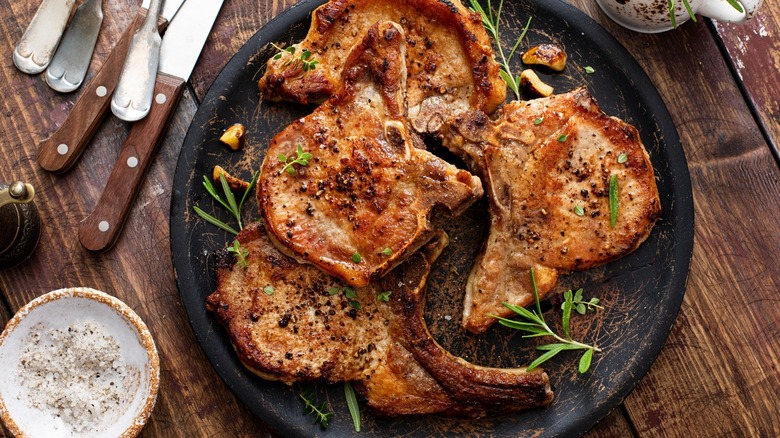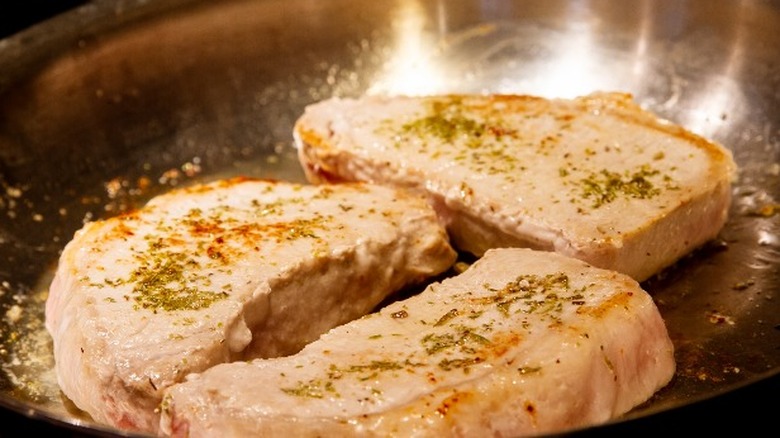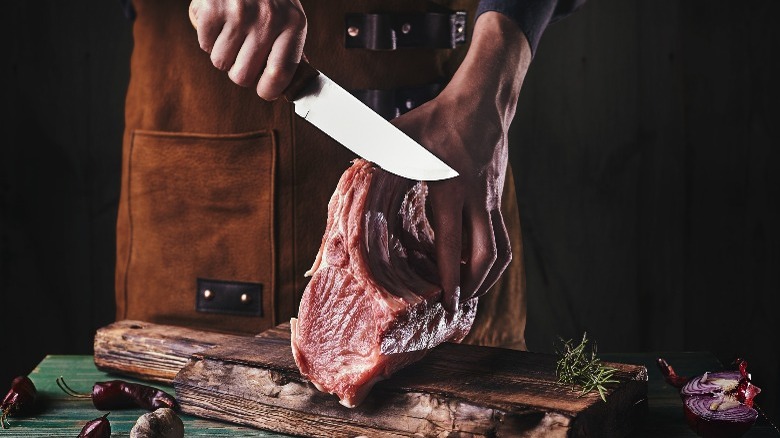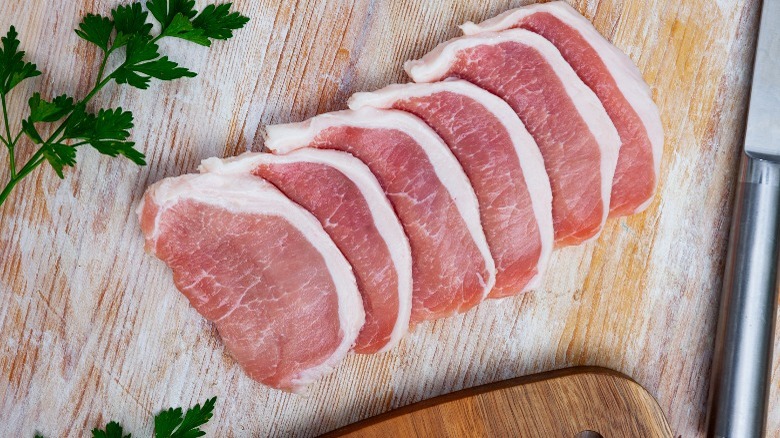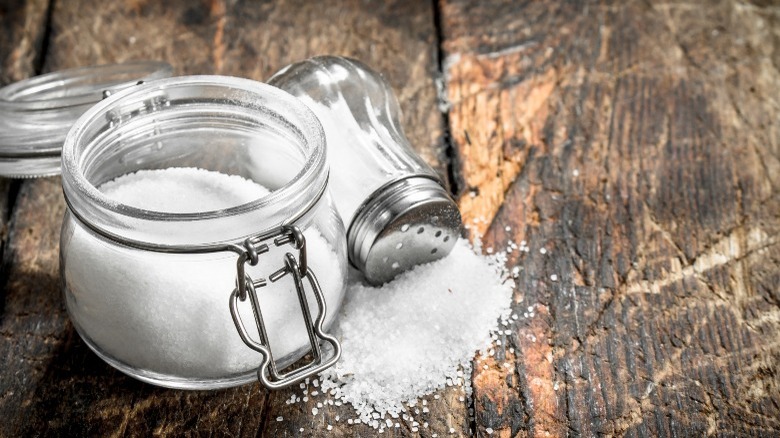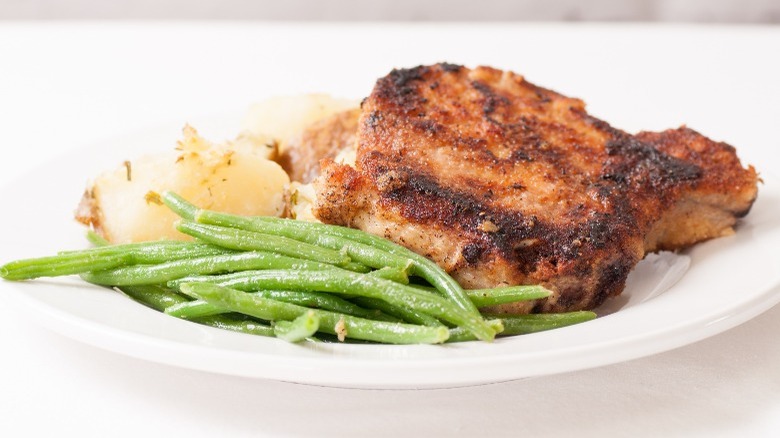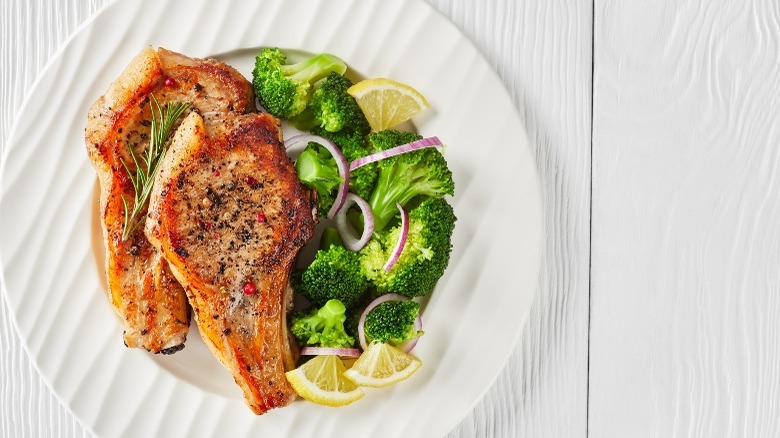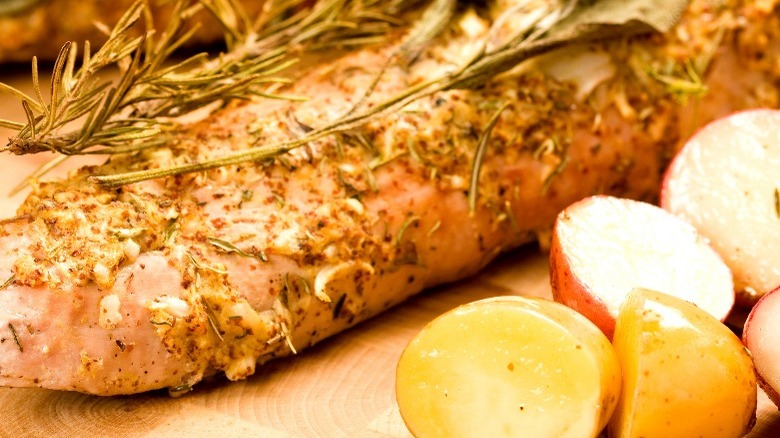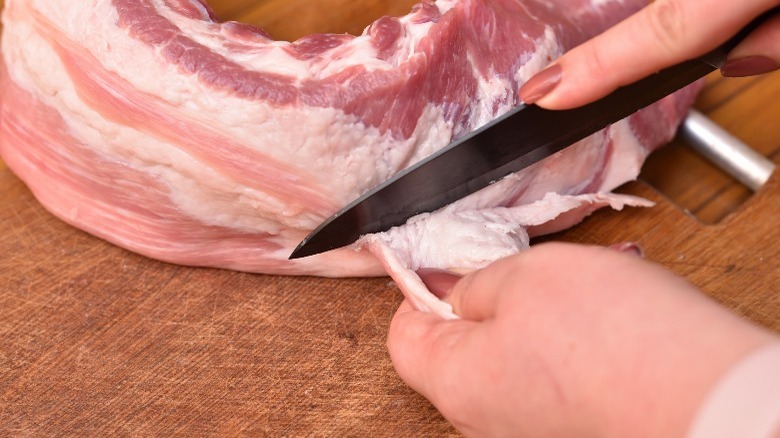11 Ways To Take Your Pork Chop Meals To The Next Level
When it comes to pork chops, it's easy to fall into the same routine of cooking them on the grill, on the stove, or in the oven without adding much personality. But there's so much you can do with this versatile meat.
Once you understand a little more about pork chops, you can improve your cooking techniques and elevate your food to the next level. You won't need to order specialty ingredients or spend hours in the kitchen to make a great dish, either.
You can buy pork chops in different thicknesses, bone-in, or bone-out. Pork.org explains that chops are sourced from the loin (the middle of the animal from hip to shoulder), but there are different names depending on where along the loin the meat comes from. Center and rib-cut pork chops are the most popular.
However you like your pork chops, these tips will ensure you cook them to perfection every time.
1. Sear pork chops first
Few things taste worse than overcooked pork chops. This is a common downfall, since this white meat cooks quickly. It can take some time to learn how to master the skill of searing since it's done quickly, but it's a great basic cooking method to know. When it's done well, the result is a mouth-watering combination of tastes and textures: The outside has a charred taste while the inside is tender and juicy.
Searing leads to something called the Maillard reaction. While it's quite a complex process to explain, on a basic level, it's a series of small chemical reactions taking place when amino acids and sugars on your pork chop are changed by heat. This leads to new colors, aromas, and flavors, making your food more appealing. For searing, Foodal suggests you use steel-clad, cast iron, or carbon steel pans, as these all allow you to cook at high temperatures. However, non-stick pans aren't great to use with high-heat cooking, so avoid these.
To avoid making mistakes while searing your meat, first dry the pork chops with paper towels and then season as desired. Add some oil and preheat the pan to around 400-450 degrees Fahrenheit (any higher and the pork will burn). After adding the pork, give it a few minutes, flip it and wait a few minutes more before removing it. Now it can be placed in the oven at a low temperature until the pork is cooked through.
2. Save money with a whole pork loin
Pork loins can be cooked whole or cut down into individual servings. The latter lets you choose portion sizes and save money. A whole loin is not the same thing as the smaller pork tenderloins you see in stores, which are smaller, and very lean.
Pork loin roasts are much larger, and you can find ones with or without bones. When you're ready to cut your pork loin roast into portions, have a clean cutting surface and sharp knives ready. Cut the loin roast horizontally into the blade end, center rib, center loin, and sirloin end (which has a lot of connective tissue). You can cut country ribs out of the blade end.
Work on the center rib section next, slicing chops into the desired thicknesses. That center loin is similar to the tenderloins described above — leave it as is and cook on its own. The final sirloin end can be chopped up into cubes for stews or curries. Package up the pork however you like, and put it into the freezer in freezer-safe bags, or into the fridge. The USDA recommends refrigerated pork lasts three to five days.
3. Preventing curled sides on pork chops
Have you ever cooked thin pork chops carefully, only to see the sides curl up? This doesn't look all that appetizing and prevents the pork from cooking evenly, as the whole piece won't be flush against the cooking surface. This tends to happen in thinner cuts of pork, and also happens with steak.
Food & Wine's Justin Chapple explains that the fat on the outside edges of the chops tightens up when heat is applied. To prevent curling, Chapple recommends using a sharp knife to score the fat before cooking. Work your way around the edges of the pork, making small slices at every half inch. Your cuts should go through the fat and stop where it meets the meat.
Meat should be scored before marinating. Doing it in reverse will be messier, plus those cuts allow the flavors to penetrate the meat better.
4. Soak pork chops in brine
Pork chops can dry out while cooking, and no one wants to eat tough chewy meat. To prevent this, try brining your meat, which is really important. As the salt is absorbed into the pork, it adds flavor and tenderizes the meat.
BBQHost says any cut of pork can be brined, adding that tougher cuts require longer soaking times. Brine recipes usually use kosher salt, and may include spices and flavorings — you might even try brines made with beer or apple juice instead of water.
Place the pork in a sealable container and cover it with fresh water. Use 1 cup of salt for each gallon of water. If you want to add other spices, mix them in with the salt before adding them to the container. Tender cuts like boneless chops only need about 30 minutes in these baths, but thicker pieces (such as a whole loin, for example) can take up to 24 hours. However, don't leave it too long as the meat can become mushy.
Cover the pork and put it in the fridge. When you're ready to cook it, remove it from the brine. Some recipes will call for you to rinse the meat before cooking, so follow whatever is suggested. Make sure to pat it dry with clean paper towels, then you're ready to cook.
5. Choose your spices wisely
Pork chops (especially boneless ones) can potentially taste bland if served without adequate seasonings. Like chicken, pork can be a blank canvas, and there is practically no limit to how it can be spiced up. You can add flavor through brines, marinades, and rubs. If breading your pork, add the spices at this stage: Combine them with your breading, put the chops in a sealable bag with your seasoned mix, and shake it up.
My Fearless Kitchen shares a list of flavors that work well with pork, starting with allspice. This adds warming flavors, with notes of cinnamon and cloves. Garlic is another good flavor that complements pork. You can try using garlic powder, garlic salt, or fresh, before combining with sage, basil, thyme, rosemary, or parsley, too. Other pork-friendly flavors include paprika, ginger, oregano, and lemon pepper. Mustard and ranch dressing are also great flavor combinations with pork, either served simply on the side, or by combining mustard with cream for an easy sauce.
6. Add a little lemon
Lemon juice is a hugely versatile ingredient, adding a punch of flavor as well as helping to tenderize meats. The acidity in lemons improves the texture of pork chops by breaking down the meat's fibers. You can swap the lemon juice out for any other acid, like pineapple or lime juice, too.
Carnivore Style recommends adding lemon juice to marinades, rather than specifically cooking with it. Aim for two hours of marinating and again, keep your pork in the refrigerator until it is ready to cook. Do not save the marinade and reuse it after the pork has been removed — many people do this but it may contain bacteria that can lead to food poisoning.
You can also use lemon peel to flavor your pork. This sous vide pork chops recipe takes a different approach: Rather than adding lemon juice to a marinade, add a piece of lemon peel in the sous vide bag with olive oil, thyme, and lemon.
7. Rub on added flavor
Nothing perks up the flavor of a pork loin or tenderloin like a dry rub – these can also add texture, as long as you use enough. Instead of just biting into the soft, seasoned meat, you get the bonus of a crispy crust. This method is one of the easiest out there, requiring little effort and time.
To make a dry rub, choose your favorite spices and mix them up in a bowl. A smoky dry rub works really well with pork, or you can also find pre-mixed spice rubs specifically made for pork. Prepare the pork by trimming off any excess fat and wiping it dry with paper towels. When using a dry rub, moisten the pork with a bit of oil. Start by using 1 tablespoon of rub per pound of pork, but feel free to add more if you want extra flavor.
Work the rub into the meat with your hands, and allow it to rest for at least an hour before cooking. Just be sure to always clean the surfaces you have prepared the raw pork on, and wash your hands thoroughly with soap and water when finished.
8. Watch the cooking times
It's not difficult to overcook pork, but it must be cooked to the proper temperature before serving. The USDA advises that pork's internal temperature should be at least 145 degrees Fahrenheit, which can be checked with a meat thermometer. Set the oven temperature to 400 degrees Fahrenheit — the meat should only need 20 minutes to be cooked through. For the best results, don't let the internal temperature exceed 160 degrees Fahrenheit, and let the pork sit undisturbed for around three minutes before slicing and serving.
A meat thermometer is a good investment, but if you don't have one to hand, try the old fashioned poke test. Use a knife or fork to poke deep into the pork, and look at the juice that flows out. If it is deep pink or red, the inside is still raw — the liquid should be clear or very pale pink. If nothing comes out, you may have cooked the pork for too long. Hey, it happens to everyone. You could add moisture with chicken stock or sauce, or chop up the pork and put it into a stew or add it to fried rice.
9. Don't cut off all that fat
When you buy a bone-in pork chop, the bone helps the meat to stay moist while cooking, due to the fat surrounding it. A boneless pork chop will still have fat around the edge, but it can be overcooked more easily, as there's less fat.
While consuming too much fat is bad for your health, leaving just enough on your pork chops will add the flavor you're looking for. However, not having enough fat can result in dry, tasteless meat. So how can you create the perfect balance?
Whether you have a pork chop with a bone in or not, it's likely you'll still need to trim some of the fat before cooking. To maintain flavor, place the raw pork chops on a clean surface and get a sharp, clean knife. The Butcher's Wife suggests trimming the fat around the edges but leaving approximately ¼ inch. You can also score the fat to prevent curling at this point.
10. Making better breaded pork chops
One of the keys to making delicious, breaded pork chops is to organize your cooking station ahead of time (via The Culinary Pro). You'll need to line up three bowls for this, with a plate or rack at the end. The first bowl gets filled with flour, the second with beaten eggs, and the third with breadcrumbs. Don't overfill the bowls, as you can always add more.
Use one hand to pick up the pork and place it in the flour. Use your other hand to dredge the pork in the flour and place it into the egg. Then back to your other hand to move it across the breadcrumbs. Finally, back to your dry hand to coat it in the breadcrumbs and place it on a rack or plate ahead of cooking.
Feel free to be creative with your ingredients. You can experiment with different types of breadcrumbs, including white, brown, or panko. The breadcrumbs can also be upgraded with sesame seeds, cheese, nuts, and even coconut, which can take your pork chop crust to the next level.
11. Give that pork a rest
Have you ever cut a piece of pork or meat right after cooking, only to see most of the juice run off onto the cutting board? It's important to let meat rest because the fibers within start to relax and reabsorb the moisture (via Virtual Weber Bullet). To put it another way, letting the meat rest helps it retain more juiciness, meaning better flavor and texture.
Thick pork chops and smaller roasts cooked on high heat should rest for 10-15 minutes, and large pork loins may need more time. If you're worried about the meat getting cold, cover it loosely with foil. However, if you want a crispy coating, covering it with foil can cause this to soften.
It's also important to not cook cold pork chops straight out of the fridge. Meat should be allowed to come up to room temperature so it cooks more easily. It's safe to let it rest for up to two hours, but most of the time you won't need to wait that long.
